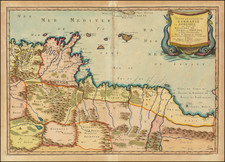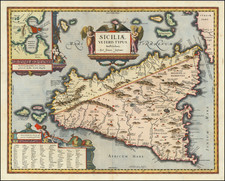The First Map of The Region Printed North of the Alps and First in Publisher's Color
Fine example of the striking 15th Century map of the southern Mediterranean and North Africa, from the famous Ulm Ptolemy, first published in 1482.
The Coast of Africa includes the modern regions of Algeria, Libya and Tunisia, extending north to include the islands of Sicily, Malta and Sardinia. A massiive mountain range demarcates the limits of the knowledge of Ptolemy's Northern Africa, with little knowledge of the Sub-Saharan regions.
This map, which covers parts of modern-day Algeria, Tunisia, Libya, Malta, Sicily, and Sardinia, was based on the cartography of the 2nd-century polymath Claudius Ptolemaeus. Ptolemy's detailed mapping of the ancient world was lost until the 13th century when it was rediscovered and redrawn (only a set of coordinates remained) by Byzantine Greek monk Maximus Planudes. Planudes's hand-drawn atlas formed the basis for a Ptolemy atlas manuscript tradition that continued until the advent of commercial printing in the middle of the 15th century.
In 1477 the first engraved Ptolemaic atlas appeared in Bologna, Italy. Three years later, the first Ulm edition was published, a woodblock printed work which included publisher's color for the first time.
The European Exploration of Africa the end of the 15th Century
Between 1480 and 1500, the exploration of Africa was predominantly driven by Portuguese navigators, building on the vision of Prince Henry the Navigator. In 1488, Bartolomeu Dias achieved a significant breakthrough by sailing around the southernmost tip of Africa, unveiling the potential for a maritime route to Asia. This exploration was furthered by Vasco da Gama, who between 1497 and 1499 successfully navigated around the Cape of Good Hope to India, inaugurating a new era of global maritime trade and European engagement with the African continent. These expeditions set the stage for the Portuguese establishment of coastal trade posts and initiated critical, albeit complex, interactions with African societies, laying a foundation for subsequent European global exploration and colonization endeavors.
The Ulm Ptolemy of 1482 and 1486
The Ulm edition of Ptolemy was first published in 1482 by Lienhart Holle. In contrast to the two earlier illustrated editions of Ptolemy's geography - Bologna (1477) and Rome (1478) - the maps in the Ulm edition are woodblock prints, not copperplate engravings. The maps in the Ulm edition follow the manuscript maps of Donnus Nicolaus Germanus, a Benedictine monk from Breslau who produced brilliant presentation copies for Italian elites in the 1460s and 1470s. Specifically, the Ulm was patterned after the manuscript atlas prepared for Pope Paul II. The Ulm Ptolemy was the first book Holle published, but it was also to be one of his last. Holle went bankrupt shortly after the original publication. The work was then taken over by Johann Reger, who issued another edition in 1486.
The differences between the two editions are relatively small. The 1486 maps typically include titles at the top, whereas there were no titles on the 1482 maps. An unpublished study of the individual maps reveals that there are multiple states of most of the maps.
It had long been suggested that the way to differentiate between the 1482 and 1486 editions was the use of lapis lazuli blue in the 1482 edition for the seas, whereas the 1486 used brown. However, the same unpublished study, which evaluated dozens of examples of the two editions, determined that the earliest examples of the 1486 were also issued with the lapis lazuli blue, suggesting that when Johann Reger acquired the woodblocks, he likely also acquired some unused lapis lazuli. In 2021, we offered for sale a complete example of a 1486 entirely in lapis lazuli blue.
Claudius Ptolemy (fl. AD 127-145) was an ancient geographer, astronomer, and mathematician. He is known today through translations and transcriptions of his work, but little is known about his life besides his residence in Alexandria.
Several of his works are still known today, although they have passed through several alterations and languages over the centuries. The Almagest, in thirteen books, discusses astronomy. It is in the Almagest that Ptolemy postulates his geocentric universe. His geometric ideas are contained in the Analemma, and his optical ideas were presented in five books known as the Optica.
His geographic and cartographic work was immensely influential. In the Planisphaerium, Ptolemy discusses the stereographic projection. Perhaps his best-known work is his Geographia, in eight books. However, Ptolemy’s ideas had been absent from western European intellectual history for roughly a thousand years, although Arab scholars interacted with his ideas from the ninth century onward.
In 1295, a Greek monk found a copy of Geographia in Constantinople; the emperor ordered a copy made and the Greek text began to circulate in eastern Europe. In 1393, a Byzantine diplomat brought a copy of the Geographia to Italy, where it was translated into Latin in 1406 and called the Cosmographia. The manuscript maps were first recorded in 1415. These manuscripts, of which there are over eighty extant today, are the descendants of Ptolemy’s work and a now-lost atlas consisting of a world map and 26 regional maps.
When Ptolemy’s work was re-introduced to Western scholarship, it proved radically influential for the understanding and appearance of maps. Ptolemy employs the concept of a graticule, uses latitude and longitude, and orients his maps to the north—concepts we take for granted today. The Geographia’s text is concerned with three main issues with regard to geography: the size and shape of the earth; map projection, i.e. how to represent the world’s curve proportionally on a plane surface; and the corruption of spatial data as it transfers from source to source. The text also contains instructions as to how to map the world on a globe or a plane surface, complete with the only set of geographic coordinates (8000 toponyms, 6400 with coordinates) to survive from the classical world.









![(Tangiers, Tzaffin, Ceuta, Arzila, and Sala) Tingis Lusitanis Tangiara. . . [on sheet with] Tzaffin [and] Salaa [and] Arzilla
[and] Septa](https://storage.googleapis.com/raremaps/img/small/54983mp2.jpg)
![[English Language Edition!] Natoliae Quae Olim Asia Minor Nova Descriptio [with] Aegypti Recentior Descriptio [with] Carthageinis Celeberrimi Sinus Typus [shows Cyprus]](https://storage.googleapis.com/raremaps/img/small/78508.jpg)
![[ Kingdom of Sardinia ] Le Royaume de Sardaigne Dressee Sur les Cartes manuscrits . . . À Venise par P. Santini 1779.](https://storage.googleapis.com/raremaps/img/small/102167.jpg)


